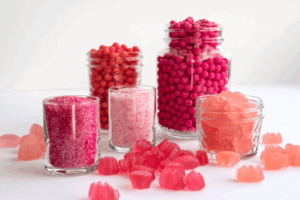Caitlin Gittins, Editor for International Confectionery talks exclusively to Dr Valeria Reim, Product Marketing Manager at CAPOL, about the growing popularity of natural ingredients in confectionery and how they are meeting demand.
You’re one of the leading companies in confectionery finishing. How do you ensure innovation in a competitive market?
We’ve been at the forefront of confectionery surface treatment for over 45 years. What has made us successful is that we keep being curious. The economy is globalised and dynamic, and the demands of confectionery manufacturers and end consumers are constantly changing. Through innovative and creative thinking, we try to understand what consumers are looking for to meet these demands. By listening closely to our customers, and looking into food trends and regulations, we anticipate how we can best support confectioners today and tomorrow. The challenges of our customers are what inspire us and keep us innovating.
In recent years, the rising “going natural” trend has become extremely noticeable, yearning for natural ingredients, sugar-reduced, vegetarian, and vegan as well as sustainable products. This is about to stay and inspires manifold new product launches in the confectionery industry.
Why are natural ingredients becoming one of the biggest trends for confectionery?
Confectionery is not a staple food but consumers still want to indulge without feeling guilty. Consumers today have become increasingly aware and conscious of their well-being and sustainability aspects and pay attention to labels when shopping.
Consequently, manufacturers are looking for appropriate ingredients to meet consumer demands for natural ingredients and easy-to-understand labels. This applies to the entire value chain of a confectionery product. We intend to support our customers with the best functional products in their specific applications while meeting the requirements of their markets and product claims. More and more often, challenges are related to making products “free from”, so avoiding certain standard ingredients that have long been used but don’t meet regulatory or consumer acceptance anymore.
(Can you give an example?)
Let’s take the example of hard-sugar-coated confections. Titanium dioxide, or TiO2, has long been the standard for pan-coating of the hard-panned white layer between an often dark-coloured core and bright colour coating. As of January 2022, following the EFSA’s decision, the European Commission has banned TiO2 as a food additive. The decision was based on concerns about genotoxicity. Apart from the negative health aspects, it is sometimes also seen as environmentally questionable as its production is associated with “large” CO2 emissions. Food and confectionery manufacturers were granted a six-month phasing-out period from February 7 until August 7, 2022. The EU ban has implications for the global industry…
To read more see our latest issue here.
Media contact
Caitlin Gittins
Editor, International Confectionery
Tel: +44 (0) 1622 823 920
Email: [email protected]








